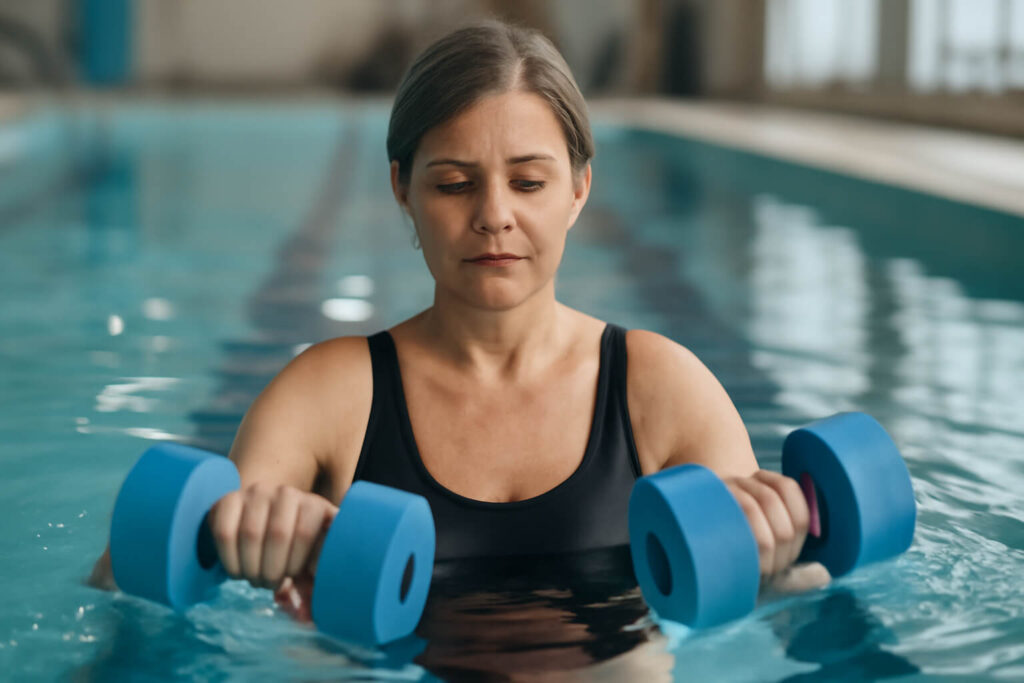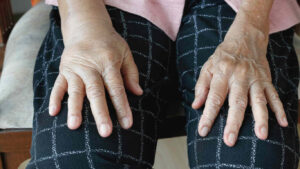Welcome to an in-depth exploration of aquatic therapy as a promising treatment for lymphedema, particularly focusing on limb and lower limb lymphedema. This article delves into the benefits of using water-based exercise to manage this chronic condition, drawing on insights from PubMed and various clinical studies. Whether you’re a patient, caregiver, or healthcare professional, this guide offers valuable information on improving the quality of life for people with lymphedema through aquatic interventions.
Understanding Lymphedema
What is Lymphedema?
Lymphedema is a chronic condition characterized by swelling, typically in the limbs, due to a compromised lymphatic system. The lymphatic system, responsible for fluid drainage, becomes impaired, leading to fluid accumulation. This results in swelling, discomfort, and reduced quality of life for affected individuals.
Causes and Symptoms of Lymphedema
Lymphedema can arise from primary or secondary causes. Primary lymphedema is often genetic, while secondary lymphedema results from factors like surgery, radiation, or infection, commonly associated with breast cancer.
| Symptom | Description |
|---|---|
| Swelling | Impacts daily activities. |
| Heavy sensation | Impacts daily activities. |
| Skin thickening | Impacts daily activities. |
| Recurring infections | Impacts daily activities. |
Impact on Quality of Life
The impact of lymphedema on quality of life is substantial. The swelling, pain, and limited mobility can hinder daily tasks and emotional well-being. Patients with lymphedema often experience anxiety and depression due to the chronic nature of the condition, making effective lymphedema management essential for improving their overall well-being. [Insert Internal Link]
The Lymphatic System and Its Role
Overview of the Lymphatic System
The lymphatic system is a vital network of vessels and tissues that removes waste and toxins from the body and plays a crucial role in immune function. It plays a crucial role in immune function by transporting lymph, a fluid containing infection-fighting white blood cells, throughout the body. Proper functioning of the lymphatic system is essential for overall health.
How Lymphedema Affects the Lymphatic System
Lymphedema directly affects the lymphatic system by disrupting its ability to effectively drain lymph fluid. This disruption can be caused by damage or blockage in the lymphatic vessels, leading to a buildup of fluid in the affected limb. Understanding this dysfunction is critical in developing effective lymphedema treatment strategies.
Importance of Lymphatic Health
Maintaining lymphatic health is crucial for preventing and managing lymphedema. Healthy lymphatic drainage ensures that fluids and toxins are efficiently removed, reducing the risk of swelling and infection. Prioritizing lymphatic health is essential for those at risk or already diagnosed with lymphedema, and there are some lymphatic therapy techniques one can use.
Aquatic Therapy as a Treatment Option
What is Aquatic Therapy?
Aquatic therapy, also known as hydrotherapy, involves performing exercises in water to promote physical and mental well-being. The buoyancy of water reduces the impact on joints, making it an ideal environment for individuals with mobility issues, such as patients with lymphedema. Aquatic exercise is a gentle yet effective method for rehabilitation.
Benefits of Aquatic Therapy for Lymphedema
Aquatic therapy offers numerous benefits for lymphedema treatment, including aiding lymphatic drainage, reducing swelling, and improving circulation. Water-based exercise also enhances muscle strength and flexibility, contributing to better limb function and overall quality of life for people with lymphedema. [Insert Internal Link]
Types of Water-Based Exercises
Various types of water-based exercises can be incorporated into aquatic therapy for lymphedema management. These include gentle movements like walking, stretching, and range-of-motion exercises. Aqua lymphatic therapy, a specialized form of aquatic therapy, focuses specifically on lymphatic drainage and can be particularly beneficial for patients with lymphedema.
Effectiveness of Hydrotherapy
Research Findings on Hydrotherapy
Research indicates that hydrotherapy can significantly improve the quality of life for patients with lymphedema, especially when focusing on limb and lower limb lymphedema. Several randomized controlled trials demonstrate that aquatic exercise, as a form of water therapy, reduces limb volume and enhances lymphatic drainage more effectively than traditional methods alone, marking an important milestone for aquatic therapy.
Systematic Review and Meta-Analysis Insights
A systematic review and meta-analysis reveals consistent positive effects of hydrotherapy on upper and lower limb lymphedema. The findings suggest that water-based exercise reduces swelling, enhances lymphatic function, and improves overall mobility. These insights support the integration of aquatic therapy into comprehensive lymphedema treatment plans, which could substantially improve lymphedema management.
Case Studies and Personal Testimonials
Case studies and personal testimonials further highlight the benefits of aquatic therapy. Many patients with lymphedema report reduced pain, increased range of motion, and improved emotional well-being following aquatic exercise programs. These first-hand accounts underscore the potential of aquatic interventions to enhance the quality of life and lymphatic drainage for people with lymphedema, emphasizing its person-centered approach.
Implementing Aquatic Therapy
How to Start Aquatic Therapy
Starting aquatic therapy involves a few key steps. Consult with a healthcare professional or a lymphedema therapist to assess your suitability for water exercise. Finding the right professional is important, with these considerations:
| Step | Description |
|---|---|
| Find a Qualified Therapist | Locate an aquatic therapist experienced in lymphedema management. |
| Therapy Guidance | They can guide you through appropriate exercises and ensure safety during aquatic sessions, tailoring the lymphatic therapy to your needs. |
Creating a Personalized Treatment Plan
A personalized treatment plan is essential for effective aquatic therapy and should consider the individual’s specific needs. This plan should consider the individual’s specific needs, including the severity and location of lymphedema, as well as any other health conditions. The plan should incorporate a variety of water exercises tailored to improve lymphatic drainage, reduce limb volume, and enhance overall lymphatic system function.
Safety Considerations
Safety is paramount when implementing aquatic therapy. Ensure the water temperature is appropriate and always have a trained therapist present to supervise the session. Ensure the water temperature is appropriate, typically between 82°F and 88°F, to promote muscle relaxation and circulation. Use caution when entering and exiting the pool, and always have a trained therapist present to supervise the session. Individuals with certain medical conditions should seek medical advice before beginning aquatic exercise.
Practical Tips for People with Lymphedema
Daily Routines and Lifestyle Adjustments
Daily routines and lifestyle adjustments can significantly impact lymphedema management, including incorporating gentle exercises, wearing compression garments, and maintaining a healthy diet. Incorporate gentle exercises into your daily routine to promote lymphatic drainage. Wear compression garments as prescribed to help control swelling. Maintain a healthy diet and stay hydrated to support overall lymphatic health, and remember that regular lymphatic therapy makes a difference.
Complementary Therapies and Practices
Complementary therapies and practices can enhance the benefits of aquatic therapy, such as Manual Lymphatic Drainage (MLD). Manual lymphatic drainage (MLD) can further improve lymphatic drainage. Skincare is also critical, as well as practices like yoga and tai chi that promote circulation and reduce stress. Consult with your healthcare provider to determine which complementary therapies are right for you, as well as which aquatic exercises suit your lymphatic needs.
Resources for Further Support
Numerous resources are available to provide further support for people with lymphedema, including the National Lymphedema Network (NLN) and the Lymphatic Education & Resource Network (LE&RN). Organizations like the National Lymphedema Network (NLN) and the Lymphatic Education & Resource Network (LE&RN) offer valuable information, support groups, and educational materials. PubMed also provides access to research articles and clinical studies on lymphedema and its treatments, including aquatic therapy and upper and lower limb lymphedema.
Conclusion and Future Insights
Recap of Key Points
Aquatic therapy is a valuable option for lymphedema management, particularly for limb and lower limb lymphedema. The benefits of water-based exercise include improved lymphatic drainage, reduced limb volume, and enhanced quality of life for patients with lymphedema. Research from PubMed supports the effectiveness of aquatic exercise as a complementary treatment.
Motivation for Ongoing Management
Ongoing management of lymphedema is crucial for maintaining long-term well-being, and aquatic therapy can provide continuous benefits. Incorporating aquatic therapy into your routine can provide continuous benefits, helping to control swelling, improve mobility, and enhance overall quality of life. Remember to consult with healthcare professionals to tailor your lymphedema treatment plan to your specific needs, to ensure you receive the best lymphatic therapy.
Future Trends in Lymphedema Treatment
The future of lymphedema treatment is promising, with ongoing research exploring innovative approaches. Emerging trends include advanced lymphatic imaging, personalized aquatic therapy programs, and the integration of technology to monitor and manage lymphedema more effectively. These advancements aim to improve outcomes and quality of life for people with lymphedema, potentially decreasing the number of patients with lymphedema.
FAQs about Aquatic Therapy and Lymphedema
What are the benefits of aquatic therapy for lymphedema?
Aquatic therapy offers several benefits for lymphedema, including improved lymphatic drainage, enhanced circulation and muscle strength, and reduced pain. Aquatic therapy offers several benefits for lymphedema. The hydrostatic pressure of water aids in lymphatic drainage, reducing swelling. Water-based exercise improves circulation and strengthens muscles, enhancing lymphatic system function and mobility. Aquatic therapy can also reduce pain and improve overall quality of life for people with lymphedema.
How often should aquatic therapy be done?
Generally, 2-3 aquatic therapy sessions per week are recommended. The frequency of aquatic therapy sessions depends on individual needs and the severity of lymphedema. Generally, 2-3 sessions per week are recommended to maintain lymphatic drainage and manage symptoms effectively. Your lymphedema therapist can help determine the optimal frequency based on your specific condition and response to aquatic exercise, and tailor your lymphatic therapy sessions.
Can aquatic therapy be done at home?
Some exercises can be adapted for home use, but consult with your healthcare provider before starting. While supervised aquatic therapy sessions with a trained therapist are ideal, some exercises can be adapted for home use, in case there are patients with lymphedema with limited access. Simple water-based movements like walking or gentle stretching in a pool or large tub can help promote lymphatic drainage. Always consult with your healthcare provider before starting a home aquatic therapy program.
Are there any risks associated with aquatic therapy?
Aquatic therapy is generally safe, but some risks exist. It is important to ensure that any aquatic exercise is performed under appropriate supervision to minimise risks. Individuals with certain medical conditions should consult their doctor before starting aquatic therapy.
| Risk | Details |
|---|---|
| Skin Irritation | From pool chemicals |
| Overheating | – |
| Falls | Entering or exiting the pool |
How does aquatic therapy compare to traditional lymphedema treatment?
Aquatic therapy complements traditional treatments by adding the benefits of water-based exercise to improve circulation, strength, and mobility. Aquatic therapy complements traditional lymphedema treatment methods like compression therapy and manual lymphatic drainage (MLD). While traditional treatments focus on reducing swelling and improving lymphatic drainage, aquatic therapy adds the benefit of water-based exercise to improve circulation, strength, and mobility. Aquatic therapy offers a holistic approach to lymphedema management by addressing both the physical and emotional aspects of the condition.





